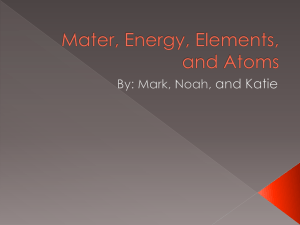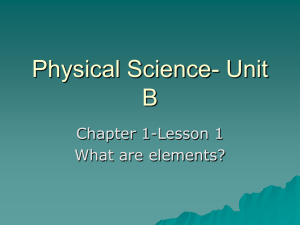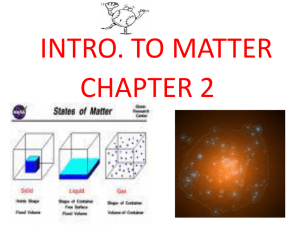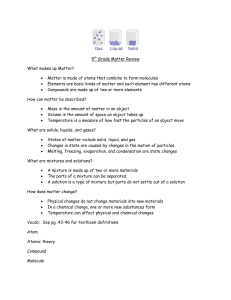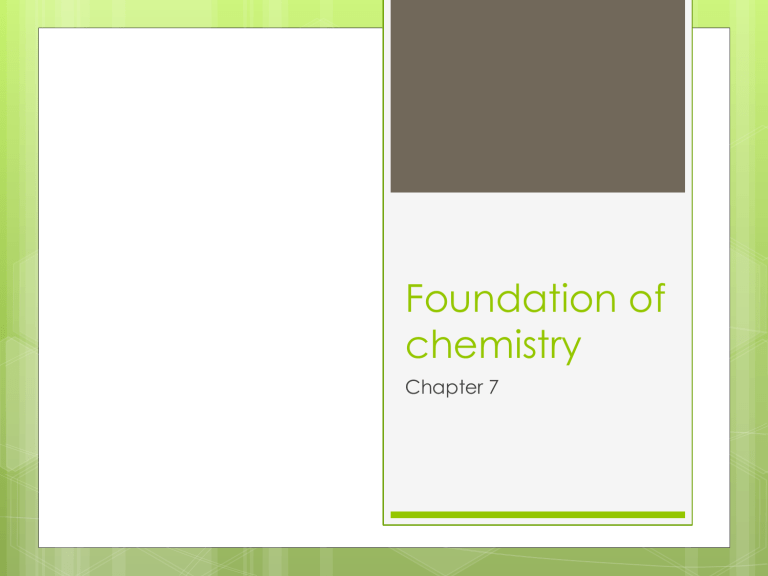
Foundation of chemistry Chapter 7 Chapter Introduction Lesson 1 classifying matter Lesson 2 physical properties Lesson 3 physical changes Lesson 4 chemical properties and changes Chapter Wrap-Up Lesson 1 Classifying matter Understanding matter Matter is anything that has mass and volume or takes up space Atom is a small particle that is a building block of matter Different arrangement of atoms make up the many types of matter Everything you can see is a matter You can’t see air , but air is a matter because it has mass and takes up space Sound and light are not matter Forces and energy are not matter To decide whether something is matter, ask yourself if it has mass and takes up space Matter: Substances and Mixtures Nearly all types of matter can be sorted into just two major categories— substances and mixtures. A substance is matter that is always made up of the same combination of atoms. Examples : Aluminum, oxygen, water , sugar A compound is matter made of atoms of two or more elements chemically bonded together. An element is a substance that consists of just one type of atoms There are two types of substances—elements and compounds. Elements There are 118 known elements There are 118 different types of atoms and each atom contains different number of protons in its nucleus Number of protons is the atomic number of the element Atoms of elements exist individually or in groups Compounds It consists of atoms of different elements Chemical formula :the combination of symbols and numbers that represent a compound, it shows the different atoms that make up a compound Ex : CO2, H2O Compound often has different properties from the individual elements that compose it Matter: Substances and Mixtures (cont.) A mixture is two or more substances that are physically blended but are not chemically bonded together. The amounts of each substance in a mixture can vary. There are two different types of mixtures—heterogeneous and homogeneous. A heterogeneous mixture is a mixture in which substances are not evenly mixed. A homogeneous mixture is a mixture in which two or more substances are evenly mixed on the atomic level but not bonded together. Another name for a homogeneous mixture is solution. How do compounds and mixtures differ? Because substances that make up a mixture are not changed chemically, some of their properties are observed in the mixture. The properties of a compound can be different from the properties of the elements that make it up. Because the substances that make up a mixture are not bonded together, they can be separated from each other using physical methods. The difference in physical properties, such as boiling points, of substances can be used to separate the substances. • Substances have a composition that does not change. The composition of mixtures can vary. • Solutions (homogeneous mixtures) are mixed at the atomic level. • Mixtures contain parts that are not bonded together. These parts can be separated using physical means. Compounds versus solutions Compounds Solution • Its composition does not vary • Chemical formula used can be used to describe the atoms that make up the compound • Is homogeneous mixture has 2 parts solute and solvent evenly mixed together but are not bonded • Composition can vary in a mixture • Chemical formula cannot be used to describe mixtures Lesson 2 Physical properties Physical properties Physical properties are the properties of a substance that can be observed or measured without changing the identity of the matter substance Density and odor or smell can help scientists identify gases and liquids The Four states of Matter Solid Liquid Gas Plasma 17 The Four States of Matter Basis of Classification of the Four Types Based upon particle arrangement Based upon energy of particles Based upon distance between particles It depends on how close and how fast States of Matter Size dependent properties State is only one of many physical properties that you can use to describe matter Some physical properties , such as mass and volume , depend on the size or amount of matter Measurements of these properties vary depending on how much matter is in a sample Size dependent properties Mass Volume • Is the amount of matter in an object • Mass doesn’t change with location • Its value depend on the size of sample • Is the amount of space something takes up • Its value depends on the size or the amount of a substance Size independent properties Some physical properties of a substance don’t depend on the amount of matter They are called size independent properties It includes melting point , boiling point , density , electrical conductivity , and solubility Melting point Temperature at which a substance changes from a solid to a liquid Boiling point Temperature at which a substance changes from a liquid to gas Density Is the mass per unite volume of a substance Conductivity Electrical conductivity is the ability of matter to conduct electricity Thermal conductivity is the ability of matter to conduct thermal energy Solubility Is the ability of one substance to dissolve in another Conductivity and solubility can be used to separate mixtures Separating mixtures Substances that make up mixtures are not held together by bonds Properties of individual substances do not change Physical properties are used to separate mixtures not compounds Lesson 3 Physical changes Physical changes Is a change in size , shape , form , or state of matter in which the matter’s identity stays the same During a physical change , the matter doesn’t become something different even thought the physical properties change change in size and shape Are physical changes so identity of matter doesn’t change Changes in states To change the state of matter , the movement of the particles has to change In order to change the movement of particles thermal energy must be either added or removed Adding thermal energy thermal energy is added to a solid, the particles in the solid move faster and faster, and the temperature increases. As the particles move faster, they are more likely to overcome the attractive forces that hold them tightly together. Adding thermal energy When the particles are moving too fast for attractive forces to hold them tightly together, the solid reaches its melting point. The melting point is the temperature at which a solid changes to a liquid.. Adding thermal energy adding more thermal energy causes the particles to move even faster. The temperature of the liquid increases. When the particles are moving so fast that attractive forces cannot hold them close together, the liquid is at its boiling point. The boiling point is the temperature at which a liquid changes into a gas and the particles spread out. Sublimation Some solids change directly to a gas without first becoming a liquid. This process is called sublimation. An example of sublimation is shown in Figure Removing thermal energy When thermal energy is removed from a gas, such as water vapor, particles in the gas move more slowly and the temperature decreases. Condensation occurs when the particles are moving slowly enough for attractive forces to pull the particles close together. Recall that condensation is the process that occurs when a gas becomes a liquid. Removing thermal energy After the gas has completely changed to a liquid, removing more thermal energy from the liquid causes particles to move even more slowly The temperature decreases and freezing occurs when the particles are moving so slowly that attractive forces between the particles hold them tightly together until it becomes solid Continue Freezing and melting are reverse processes, and they occur at the same temperature. The same is true of boiling and condensation. Deposition is the change from a gas directly to a solid, as shown in Figure. It is the process that is the opposite of sublimation. Lesson 4 Chemical changes Chemical properties Recall that a physical property is a characteristic of matter that you can observe or measure without changing the identity of the matter. However, matter has other properties that can be observed only when the matter changes from one substance to another. Examples what are some chemical properties of a piece of paper? Can you tell by just looking at it that it will burn easily? The only way to know that paper burns is to bring a flame near the paper and watch it burn. When paper burns, it changes into different types of matter. The ability of a substance to burn is a chemical property. The ability to rust is another chemical property Comparing properties All matter can be described using both types of properties. Ex :The log also has mass, volume, and density, which are physical properties that can be measured. The ability of wood to burn is a chemical property. This property is obvious only when you burn the wood. Comparing properties It also will rot, another chemical property you can observe when the log decomposes, becoming other substances. When you describe matter, you need to consider both its physical and its chemical properties. Chemical changes Chemical change is a change in matter in which the substances that make up the matter change into other substances with new physical and chemical properties. For example, when iron undergoes a chemical change with oxygen, rust forms. The substances that undergo a change no longer have the same properties because they no longer have the same identity. Chemical signs Signs of chemical changes include the formation of bubbles or a change in energy, odor, or color. It is important to remember that these signs do not always mean a chemical change occurred. the only proof of chemical change is the formation o a new substance. Explaining chemical reactions Particles in matter are in constant motion. As particles move, they collide with each other. the bonded atoms that make up the particles can break apart. These atoms then rearrange and bond with other atoms. Explaining chemical reactions When atoms bond together in new combinations, new substances form. This process is called a reaction. Chemical changes often are called chemical reactions. Using chemical formula A useful way to understand what happens during a chemical reaction is to write a chemical equation. A chemical equation shows the chemical formula of each substance in the reaction. Using chemical formula The formulas to the left of the arrow represent the reactants. Reactants are the substances present before the reaction takes place. The formulas to the right of the arrow represent the products. Products are the new substances present after the reaction. The arrow indicates that a reaction has taken place. Balancing chemical equations during both physical and chemical changes, mass is conserved. This means that the total mass before and after a change must be equal. Therefore, in a chemical equation, the number of atoms of each element before a reaction must equal the number of atoms of each element after the reaction. This is called a balanced chemical equation Write the equation , and check to see if it is balanced The rate of chemical reaction Particles that make up matter are constantly moving and colliding with one another. Different factors can make these particles move faster and collide harder and more frequently. These factors increase the rate of a chemical reaction A higher temperature usually increases the rate of reaction. When the temperature is higher, the particles move faster. Therefore, the particles collide with greater force and more frequently. Temperature A higher temperature usually increases the rate of reaction. When the temperature is higher, the particles move faster. Therefore, the particles collide with greater force and more frequently. Concentration Concentration is the amount of substance in a certain volume. A reaction occurs faster if the concentration of at least one reactant increases. When concentration increases, there are more particles available to bump into each other and react. Surface area Surface area also affects reaction rate if at least one reactant is a solid. If you drop a whole effervescent antacid tablet into water, the tablet reacts with the water. However, if you break the tablet into several pieces and then add them to the water, the reaction occurs more quickly. Smaller pieces have more total surface area, so more space is available for reactants to collide.
